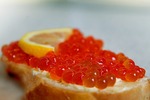PROTECT YOUR DNA WITH QUANTUM TECHNOLOGY
Orgo-Life the new way to the future Advertising by Adpathway Red caviar
Red caviarIn 2024, overall exports of caviar made from fish eggs were worth a total US$527.8 million.
Total sales for exported caviar appreciated by 27.8% from $413 million five years earlier in in 2020 and grew in value by 4.8% compared to $503.5 million sold on international markets during 2023.
Of the dollar amount for 2024, $223.2 million or 42.3% of globally exported caviar was for sales of traditional caviar compared to the 42.9% share in 2023. The traditional delicacy is made from the internal egg masses of wild sturgeon sourced from the Caspian Sea or the Mediterranean’s Black Sea.
Alternative forms of caviar, made from fish other than sturgeon, accounted for revenues were $304.6 million or about 1.36 times the total for exported traditional caviar. This multiple belies the fact that the average unit price for traditional caviar ($228,232 per ton) is 13.3 times the average unit for caviar made from non-sturgeon fish eggs ($17,173 per ton).
Key Statistical Insights by Type of Caviar
Revenues from exported traditional caviar accelerated by 107.5% over the 5-year period starting in 2020 but slowed to a 2.8% gain from 2023 to 2024. International sales of exported caviar alternatives flatlined via a -0.3% reduction over the five-year period but a 6.4% expansion from one year earlier in 2023.
The top 5 exporters of traditional caviar by overall sales are mainland China, Italy, France, Poland and Germany. Combined, those leading exporters generated just over three-quarters (75.5%) of global sales for traditional caviar.
Nearly three-fifths (59.5%) of its global total, the 5 major exporters of caviar alternatives accounted for a less concentrated percentage compared to traditional caviar. The main shippers of caviar alternatives are Japan, mainland China, Germany, United States of America and Denmark.
From a continental perspective, 47.7% of traditional caviar exports came from Asia trailed by international suppliers in Europe (47.1%). Smaller percentages originated in North America (2.7%), Africa (1.5%), Latin America plus the Caribbean (1%), then New Zealand and Australia in Oceania (0.01%).
Focusing on the non-sturgeon alternative caviar exports, the leading continental supplier entities are located in Europe (45.9% of the world total), Asia (44.5%), North America (8.9%), Latin America plus the Caribbean (0.6%), Oceania’s Australia, Norfolk Island and New Zealand (0.16%), then Africa (0.01%).
In addition to total export sales for traditional and alternative caviar, this article delves into the lowest and highest average unit prices per ton as well as the major export countries as measured by shipment weight.
For research purposes, the Harmonized System (HS) code is 160431 for traditional caviar. The HS code is 160432 for caviar substitutes made from non-sturgeon fish eggs.
Top Exporters of Traditional Caviar by Global Sales
Listed below are the most lucrative countries for supplying traditional caviar in 2024 ranked by total international sales.
Also shown is percentage that each country represents in terms of globally exported caviar from sturgeon eggs sourced from the Black Sea or the Caspian Sea.
- mainland China: US$98 million (43.9% of traditional caviar exports)
- Italy: $21.9 million (9.8%)
- France: $20.6 million (9.2%)
- Poland: $14.2 million (6.4%)
- Germany: $13.8 million (6.2%)
- Belgium: $11.8 million (5.3%)
- Bulgaria: $4.7 million (2.1%)
- United States: $4 million (1.8%)
- Madagascar: $3.3 million (1.5%)
- Netherlands: $2.9 million (1.3%)
- Greece: $2.7 million (1.2%)
- Hong Kong: $2.6 million (1.2%)
- Latvia: $2.5 million (1.1%)
- Canada: $2.03 million (0.9%)
- Spain: $1.97 million (0.9%)
By value, the above 15 main export countries furnished 92.8% of globally exported traditional caviar in 2024.
Posting the strongest gains in international sales of traditional caviar from 2023 to 2024 were Canada (up 183.5%), Hong Kong (up 41%), Netherlands (up 26.6%), mainland China (up 18.4%) and Latvia (up 12.9%).
Double-digit declines among the top 15 exporters of traditional caviar belonged to suppliers in the United States of America (down -46.4% from 2023), Bulgaria (down -18.4%), Italy (down -14.3%), Greece (down -12.9%) and Germany (down -10.2%).
Top Alternative Caviar Exporters by Global Sales
Listed below are the best countries that benefit from selling caviar made from non-sturgeon fish eggs on international markets during 2024.
Also shown is percentage that each country represents in terms of globally exported alternative caviar.
- Japan: US$64.2 million (21.1% of alternative caviar exports)
- mainland China: $47 million (15.4%)
- Germany: $37.4 million (12.3%)
- United States: $17.2 million (5.6%)
- Denmark: $15.6 million (5.1%)
- Sweden: $14.6 million (4.8%)
- Russia: $11 million (3.6%)
- Canada: $9.7 million (3.2%)
- Netherlands: $8.9 million (2.9%)
- Vietnam: $6.4 million (2.1%)
- South Korea: $6.1 million (2%)
- Iceland: $5.9 million (1.9%)
- Spain: $5.8 million (1.9%)
- Latvia: $5 million (1.6%)
- France: $4.9 million (1.6%)
By value, the above 15 main export countries represent 85.2% of alternative caviar exported in 2024. That percentage reveals a less concentrated cohort of international suppliers compared to the 92.8% for 15 major exporters of traditional caviar made from sturgeon eggs.
The fastest-growing top exporters of non-traditional caviar from 2023 to 2024 were those located in Vietnam (up 419.8%), Canada (up 373.8%), Russia (up 38.8%) and the United States of America (up 21.8%).
The following supplier countries recorded the greatest year-over-year reductions: Iceland (down -29.9% compared to 2023), South Korea (down -16.3%), Netherlands (down -3.1%) and Sweden (down -2.6%).
Lowest and Highest Unit Prices for Traditional Caviar Exports
In 2024, the world’s average unit price for caviar made from sturgeon eggs from the Black Sea or the Caspian Sea was US$228,223 per ton. The average unit price for traditional caviar fell by -3% from an average $235,198 per ton for 2023.
The top exporter of traditional caviar, mainland China, charged an above average $304,211 per ton in 2024.
Ranked in ascending order, listed below are the countries exporting traditional caviar charging the lowest unit prices in 2024.
- Lithuania: US$10,160 per ton (down -9.6% from 2023)
- South Africa: $13,000 per ton (up 129.4%)
- Russia: $13,741 per ton (down -95.4%)
- Türkiye: $23,167 per ton (down -25%)
- Norway: $30,333 per ton (2023 data unavailable)
- Canada: $34,407 per ton (up 20.1%)
- United States: $45,500 per ton (down -9.9%)
- Sweden: $83,000 per ton (up 22.1%)
- United Arab Emirates: $83,667 per ton (down -82.3%)
- Denmark: $93,833 per ton (up 108%)
- Belarus: $94,462 per ton (down -16.9%)
- Latvia: $106,000 per ton (up 27%)
- Netherlands: $225,077 per ton (down -12.3%)
- Poland: $233,049 per ton (up 38.9%)
- Kazakhstan: $243,000 per ton (2023 data unavailable)
Posting double-digit reductions in unit price per ton for traditional caviar were Russia (down -95.4% from 2023), United Arab Emirates (down -82.3%), Türkiye (down -25%), Belarus (down -16.9%) then the Netherlands (down -12.3%).
The following countries shipped exported traditional caviar at the highest average unit prices.
- Azerbaijan: US$1,243,000 per ton (up 111.8% from 2023)
- Israel: $846,000 per ton (up 45.4%)
- France: $687,300 per ton (down -5.7%)
- Luxembourg: $632,500 per ton (up 17.2%)
- Uruguay: $603,333 per ton (up 22.8%)
- Belgium: $561,286 per ton (down -6.7%)
- Germany: $531,038 per ton (down -10.2%)
- Hong Kong: $523,800 per ton (up 12.8%)
- Georgia: $500,000 per ton (up 104.1%)
- Madagascar: $471,714 per ton (up 20.4%)
- Italy: $446,449 per ton (up 17.2%)
- Chile: $357,000 per ton (up 55.9%)
- Iran: $350,800 per ton (down -52.4%)
- Czech Republic: $350,000 per ton (down -12.3%)
- United Kingdom: $308,000 per ton (up 11%)
Posting the greatest advances in terms of average unit price hikes for traditional caviar were: Azerbaijan (up 111.8% from 2023), Georgia (up 104.1%), Chile (up 55.9%), Israel (up 45.4%) then Uruguay (up 22.8%).
Lowest and Highest Unit Prices for Non-Traditional Exported Caviar
In 2024, the world’s average unit price for caviar made from non-sturgeon fish eggs was US$17,173 per ton—just 7.5% of the global average unit price for traditional sturgeon caviar ($228,223 per ton).
The world average unit price for caviar alternatives slowed by -8.8% from an average $18,832 per ton one year earlier during 2023.
The top exporter of caviar alternatives made from non-sturgeon fish eggs, Japan, charged a comparatively high $29,317 per ton in 2024.
Ranked in ascending order, listed below are the countries collecting the lowest average unit prices for exported caviar alternatives in 2024.
- South Africa: US$3,000 per ton (up 50% from 2023)
- Iran: $3,933 per ton (down -60.7%)
- Malaysia: $4,100 per ton (down -91.4%)
- Norway: $4,224 per ton (down -32.1%)
- Kazakhstan: $4,686 per ton (down -27.9%)
- Belarus: $5,832 per ton (down -6.8%)
- Greece: $6,574 per ton (up 6.3%)
- Armenia: $7,906 per ton (down -27.3%)
- Thailand: $8,643 per ton (down -48.1%)
- Vietnam: $9,234 per ton (down -69.8%)
- Slovenia: $10,000 per ton (down -67.4%)
- Ukraine: $10,655 per ton (up 16.7%)
- Sweden: $11,060 per ton (up 14.3%)
- mainland China: $11,540 per ton (down -12.3%)
- Greenland: $11,922 per ton (down -24.2%)
Posting decreases in their average unit price per ton for non-traditional caviar since 2023 were low-cost providers Malaysia (down -91.4%), Vietnam (down -69.8%), Slovenia (down -67.4%), Iran (down -60.7%) and Thailand (down -48.1%).
The following countries shipped exported caviar alternatives charging the greatest average unit prices.
- Australia: US$147,667 per ton (down -14.1% from 2023)
- Switzerland: $128,000 per ton (down -2.3%)
- Ireland: $83,583 per ton (up 0.7%)
- Luxembourg: $65,333 per ton (up 9.7%)
- Estonia: $54,130 per ton (down -4.6%)
- Italy: $52,568 per ton (down -9.4%)
- Finland: $42,456 per ton (up 5.2%)
- Belgium: $41,500 per ton (up 2.3%)
- Indonesia: $37,323 per ton (down -23.8%)
- Taiwan: $37,000 per ton (up 11.3%)
- Denmark: $35,855 per ton (2023 data unavailable)
- Georgia: $35,000 per ton (2023 data unavailable)
- Singapore: $34,800 per ton (up 21.2%)
- Croatia: $34,000 per ton (2023 data unavailable)
- Hong Kong: $32,333 per ton (2023 data unavailable)
The greatest upticks in terms of higher average unit prices for non-traditional caviar in 2024 compared to 2023 were charged by sellers in Singapore (up 21.2%), Taiwan (up 11.3%) then Luxembourg (up 9.7%).
Biggest Exporters of Traditional Caviar by Weight
As measured by shipment weight, a total 978 tons in traditional sturgeon caviar was exported during 2024.
The overall weight of globally exported caviar rose 6% compared to 2023 and increased by 28.2% since 2020.
Ranked by shipped weight, listed below are the top 15 shippers of traditional caviar exports generating 93.9% of the world total.
- mainland China: 322 tons (32.9% of traditional caviar tonnage)
- Lithuania: 156 tons (16%)
- United States: 88 tons (9%)
- Poland: 61 tons (6.2%)
- Canada: 59 tons (6%)
- Italy: 49 tons (5%)
- France: 30 tons (3.1%)
- Russia: 27 tons (2.8%)
- Germany: 26 tons (2.7%)
- Latvia: 24 tons (2.5%)
- Belgium: 21 tons (2.1%)
- Bulgaria: 17 tons (1.7%)
- Belarus: 13 tons (1.3%)
- Netherlands: 13 tons (1.3%)
- Türkiye: 12 tons (1.2%)
The strongest year-over-year increases in terms of shipment weight for traditional caviar suppliers were posted by those located in Russia (up 800% from 2023), Lithuania (up 151.6%), Canada (up 136%), Belarus (up 85.7%) then Türkiye (up 50%).
The strongest declines in total shipment weight since 2023 were experienced by exporters in the United States of America (down -40.5%), Italy (down -26.9%), Poland (down -23.8%) and Bulgaria (down -22.7%).
Biggest Exporters of Non-Traditional Caviar by Weight
A total 17,737 tons of caviar from non-sturgeon fish eggs were exported around the globe in 2024.
That overall shipment tonnage reflects a -45.1% reduction from 32,312 tons five years earlier in 2020 but a 17.7% acceleration from 15,070 tons for 2023.
By weight, the following is a ranking of the 15 largest shippers of exported alternatives to traditional caviar accounting for 88% of the world’s total.
- mainland China: 4,075 tons (23% of alternative caviar exports)
- Japan: 2,190 tons (12.3%)
- Germany: 1,597 tons (9%)
- Sweden: 1,318 tons (7.4%)
- Kazakhstan: 1,004 tons (5.7%)
- United States: 791 tons (4.5%)
- Norway: 732 tons (4.1%)
- Vietnam: 689 tons (3.9%)
- Belarus: 624 tons (3.5%)
- Russia: 511 tons (2.9%)
- Canada: 457 tons (2.6%)
- Denmark: 434 tons (2.4%)
- Iceland: 412 tons (2.3%)
- Ukraine: 386 tons (2.2%)
- Netherlands: 381 tons (2.1%)
Recording the strongest increases in shipment weight of non-traditional caviar were exporters in Vietnam (up 1,623% from 2023), Canada (up 464.2%), Norway (up 81.6%), Ukraine (up 49.6%), Kazakhstan (up 42.8%) then the United States of America (up 41.3%).
There were 3 decliners as measured by year-over-year volume reductions: Iceland (down -18.1% from 2023), Sweden (down -14.7%) then Belarus (down -8.1%).
See also Top Salmon Exports & Imports by Country, Big Export Sales for Frozen or Fresh Shrimps, Frozen Fish Exports by Country, Top Water and Ice Exporters and Top Saffron Exports & Imports by Country Plus Average Prices
Research Sources:
Central Intelligence Agency, The World Factbook Field Listing: Exports – Commodities. Accessed on June 23, 2025
International Trade Centre, Trade Map. Accessed on June 23, 2025
Wikipedia, Caviar. Accessed on June 23, 2025


 2 weeks ago
2
2 weeks ago
2










 English (US) ·
English (US) ·  French (CA) ·
French (CA) ·  French (FR) ·
French (FR) ·